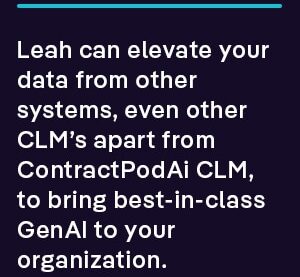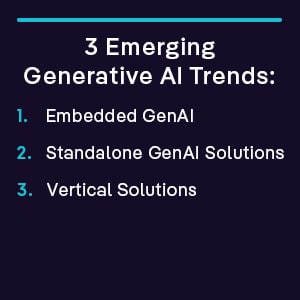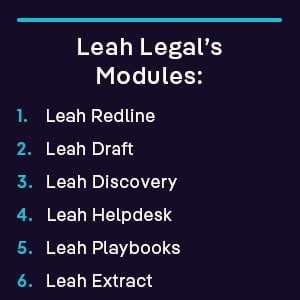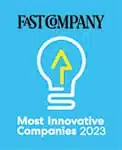We are fortunate to be one of the pioneers shaping the future of Generative AI for the enterprise. Our decade-long journey with AI-driven solutions for legal tech has given us real-world experience that is guiding us forward with practical GenAI solutions. Every organization is asking how they can use, test, or adopt GenAI. It’s not always a straightforward answer due to the pace of innovation and other domain-specific variations. One of the trends we see emerging is a debate around whether to embed GenAI into existing solutions or applications, select a standalone GenAI solution or a vertical solution. We believe there is a need for all three.
In Salesforce’s latest State of IT report, they found that 67% of those surveyed have prioritized generative AI for their business, but there are barriers to adoption, such as employees lack the skills to use it successfully, can’t integrate with their business’s current tech stack and organizations lack a unified data strategy.
As we have continued to innovate and collaborate with our partners, we see some options for adopting GenAI that can help organizations plan their moves with more clarity and confidence. In this article, we explore three ways organizations can start to tackle those barriers to move forward in their AI journey.
Embedded GenAI
Let’s start with embedded GenAI into existing applications or systems. This is where many solution providers are starting or have started. There are many examples in the market of vendors adding GenAI capabilities into their existing solutions. As an example, adding GenAI—powered features in our Contract Lifecycle Management and Legal Intake solutions.
Example of Embedded GenAI
Leah has up-leveled negotiations for our customers through GenAI-enabled automation and precedence-based negotiation recommendations. As an example, Leah’s drag and drop, smart automated record creation removes friction from each step in the process. She then provides redline recommendations based on organizations, contract data, and precedence, in real-time. In this scenario, Leah not only saves time and increases productivity—but improves the overall accuracy of contract redlines. As a solution provider, we will continue to add GenAI-assisted features and capabilities to our Contract Lifecycle Management (CLM) and Legal Intake applications where it makes sense for our users.
For organizations who want to start using GenAI, you can start with asking their technology providers about strategy and roadmap, and how it will impact existing experience and applications.
Standalone GenAI Solutions
As GenAI adoption continues within the legal sector, new use cases and products emerge. One of the areas we anticipated was the need for a standalone GenAI solution for lawyers, whether they were at a Law Firm, Corporation or Alternative Legal Service Provider (ALSP). While Leah is currently focused on Legal, we see this as an emerging trend; solutions formulated for specific domains.
Large Language Models (LLMs) from OpenAI, Google, Anthropic, and others are powerful, but they are generalists. For specific domains like legal, finance, marketing, human resources, etc., the models sometimes need to be combined or further fine-turned to resolve domain specific challenges. In my recent blog post, I dive into what is required for domain-specific frameworks and custom models in enterprise settings, particularly focusing on the unique aspects and needs of such implementations.
Standalone, Domain Specific Generative AI Solutions
In June, we launched Leah Legal, a standalone GenAI solution for lawyers. Leah is designed for professional use and comes with out-of-the-box modules designed for legal tasks and use cases.
Some of Leah’s modules include:
- Leah Redline the gold standard for utilizing GenAI and customized models for redlining
- Leah Draft a module for quickly drafting professional legal documents
- Leah Discovery for in-depth complex legal analysis across interlinked documents for contract analysis, M&A, and Litigation use cases
- Leah Helpdesk for real-time legal guidance based on an organization’s policies, procedures, and legal and compliance guidelines, and more
- Leah Playbooks to automate playbook creations from precedence
- Leah Extract for extracting critical legal and business data
These are a few examples of modules intentionally designed for legal professionals to use from day one.
Standalone solutions, like Leah, deliver an easy, conversational interface that can simplify complex tasks, or streamline time consuming projects. They will be an essential component to AI-forward teams, easy to deploy and built on the most sustainable LLMs that deliver built-in guardrails for ethics and data accuracy.
GenAI solutions create immeasurable opportunities for operational efficiencies and productivity gains. In the case of Leah, the focus is on legal use cases—like mergers and acquisitions, deals, claims, litigation and more. Leah can be fine-tuned for organizations’ use cases and nuances. These models become customized for the customer, driving conclusions, generating analysis and documents based on the organization’s standards.
Vertical Solutions

Leah is architecturally designed to function as a legal vertical solution. Leah can connect to an organization’s other systems, enabling our customers to incorporate GenAI into their overall ecosystem without replacing their existing technology stacks. Leah can elevate your data from other systems, even other CLM’s other than ContractPodAi CLM, to bring best-in-class GenAI to your team and organization.
Looking Forward
One thing is certain, GenAI will continue to push business forward, leap-frogging what we know today, and dominate the media and technology purchases of 2024. As you start to evaluate and adopt GenAI, having an overarching approach to how you can deploy quickly to test and learn, while thinking strategically can help bring clarity to your process. Whether it’s asking your current vendors about their roadmaps, considering copilots for specific domains, and even thinking down the line to a vertical solution leveraging your internal knowledge bases and data.









